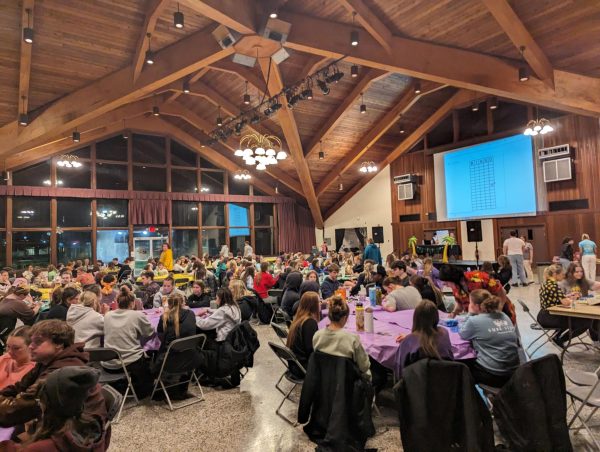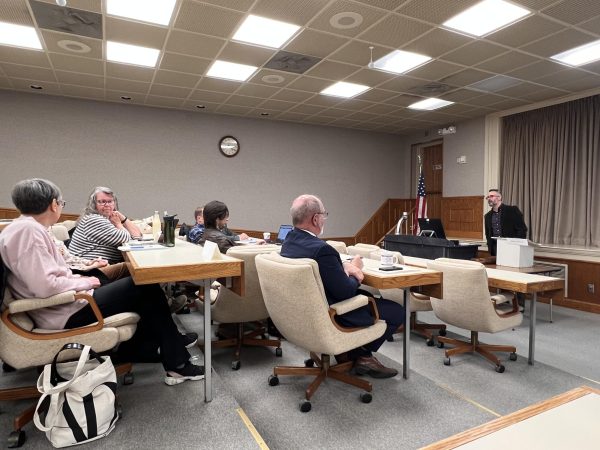Library Elevator traps three students
February 23, 2012
When stuck in an elevator, some people think about nothing because they are unconscious. Racheal Breeden was stuck in an elevator for five minutes when she was 13 years old, and she passed out.
Others’ thoughts run rampant. Terrion Saunders thought about his mom.
Around 7 p.m. on December 5, Saunders and two of his classmates worked on their project for Human Communications on the fourth floor of the library. When finished, they began riding the elevator to the main floor until they heard screeching metal and a brake stop their elevator in between the second and third floors. Saunders thought the doors would open, but they never did. The other elevator was already broken down at the time.
Saunders, Blake Bates and Kyle Madden pushed the emergency button. Saunders said they were waiting for twenty minutes. Bates said it was thirty-five.
Cathy Moffett of Safety Services took the call. Saunders said, until she was able to help them, the three students didn’t know if anyone was responding to their emergency, and Madden did what he could to help themselves. He used his laptop to post on his Facebook page, “We’re stuck in an elevator. Help!”
They sat and waited. Though Saunders did not want Madden and Bates to detect his worry, he began to think of the tragedies that could occur. What if the power cut out, and the elevator fell and exploded? Was that possible? They had pushed the emergency button—but what if no one had heard it?
“I don’t like being in small spaces, anyway,” Saunders said. “I always think I am going to run out of air or something.”
Bates and Madden joked with Saunders about being stuck in the elevators forever—that perhaps they would have to resort to eating each other in order to stay alive.
Bates said Madden played Drake’s new CD on his laptop. They listened to the song “Take Care.”
Of course Saunders was not panicking or upset, but the confinement and the waiting and the silence grew stressful. He questioned, for a moment, what would happen if he did die on an elevator, and he thought of his best friend—his mom.
“What would my mom do? I knew I wasn’t going to die, but for that split second…Then I thought, ‘Maybe if I die, I won’t have to do the project,’” Saunders said with a chuckle.
Losing each other would be equally hard. Saunders said he never knew his biological father, only his stepfather, so he has always been close to his mom.
In 2005, their relationship grew deeper. His mom overcame a drug addiction and survived a heart attack in the same year, with help from a church. She underwent a spiritual transformation and became a devout follower of Christ. Saunders admired her even more because her change was a testament to him that he needed to believe in God as well.
“That really drew me closer to my mom. I was proud of her,” Saunders said.
When Saunders is stressed, he said he talks to his mom. He talks to her every day, about anything that upsets him—problems that he doesn’t tell his closest friends—and he said she shares things that sometimes she does not tell Saunders’s stepfather. On the elevator, he would have liked to hear her voice.
Briefly, Bates said he considered the elevator plummeting as well, though he was more concerned with the length of time for which he would be trapped. Soon he would be hungry, he had homework to do, and it would be uncomfortable to sleep in the elevator.
In 2008, The New Yorker reported about a man who spent 41 hours trapped in an elevator in a McGraw-Hill building in New York City. There is video of Nicholas White on the website, recorded at 40 times the regular speed, to view White’s 41-hour experience in only a few minutes.
In the article, reporter Nick Paumgarten also cited David Hoberman, a producer of “Monk,” who had been undergoing behavioral elevator therapy for his fear of boarding an elevator. Hoberman reportedly said, “I don’t have a fear of dying in an elevator, or of the elevator losing control—I have a fear of being stuck with my mind.”
The time spent thinking for 41 hours might have been unbearable for Hoberman. As the seconds ticked, Bates wanted out before then, as well.
The three anxiously awaited a rescue, but Bates said that he wasn’t nervous in the elevator. Neither was Brandy Alexander during her freshman year at AU, but she was only stuck in Clayton’s elevator for ten minutes before Safety Services came to assist her and the other two students on board. The doors were jammed, but they weren’t stuck in between floors.
“At no point was I afraid for my life or thought we would drop or anything like that, and thankfully, I’m not afraid of closed spaces,” Alexander said.
Both Bates and Alexander were simply thinking about getting off the elevator.
But Breeden passed out. The last thing she remembered seeing was the dimly lit number 12 when the lights cut out unexpectedly. Everything she was holding fell from her arms. She was trying to get to the fifteenth floor of the Westin Hotel in Columbus. The elevator jolted, slid downwards to adjust, and stopped again. Having a fear of darkness and closed spaces, Breeden began to panic and breathe heavily. She was born with asthma, and when she panics, the pathways to her lungs constrict.
She dropped to the floor, grabbed her belongings, and scooted to the corner, frantically searching through her purse for her inhaler, though she could see nothing in the darkness. She began to feel a disorientation similar to blacking out after giving blood. She slumped in the corner. She never made it to her inhaler.
Then Breeden heard a ringing, like her alarm clock, and she asked herself if she was waking from a bad dream. It was the emergency phone. The man calling to her said a breaker had gone out. He asked if she needed an ambulance. No, her panic attack was over.
The man told her they would start the elevator in a couple minutes—that it would sound like it was falling, but it wouldn’t.
Breeden said her heart dropped, and she asked herself, “What if it actually does start falling?” But she took deep breaths and eventually they rescued her. The bell hop escorted her down thirteen flights of stairs, and she didn’t ride elevators for the next three years.
Had Breeden been awake, she said she would have been panicking mostly from the darkness, her “overactive imagination” telling her that something might crawl out of the tiles and get her. But as it was, she was not in a horror movie, and her only thoughts were of her inhaler.
The thinking soon became more necessary for the three boys in the library elevator after Moffett arrived.
She talked to them through the door of the elevator and instructed them to find the lever in the corner of the elevator door, which Saunders said took ten minutes.
After they pulled the lever, the doors opened, and there was a small space to where they could crawl out of the elevator, parked uneven with the floors. Saunders said he questioned the safety of crawling out of the elevator, concerned whether it would budge and clip him while he was crawling.
In 2007, the New York Times reported that, according to the Consumer Product Safety Commission, only 70 people have died from elevator injuries from 2001 to 2006, which is a low number in comparison to the frequency of elevator use in America.
The elevators are supported by brakes and as many as ten cable cords. Although unlikely, being crushed by elevators sometimes occurs.
“I figured, ‘Well, I can’t be in an elevator the rest of my life,’ so I kind of went as quick as I could,” Saunders said. They all made it out safely.
Saunders took the stairs the next time he went to the library, though both Saunders and Bates said they are not afraid of elevators. They are aware now, however, that it’s not unusual for elevators to stop working.
“You just never know what’s going to happen in an elevator,” Bates said.











